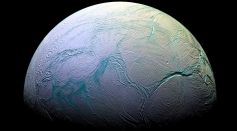CHEMISTRY
Notable Discoveries in Science 50, 100, and 150 Years Ago That Are Not Widely Known
Copper Atoms Kept Closer to Combat Bacteria, New Approach Shown in Study

Chemical Recycling Repurposes Diapers into Adhesives Removing Millions of Sodden Diaper Wastes
Life on Venus: Volcanic Activities Might Explain the Presence of Phosphine in the Atmosphere
Fluorescence Used to Monitor Water Quality by Detecting Hydrocarbons and Pesticides in Real-time
Water Fleas' Rapid Evolution: New Study Identifies More Than 300 Varying Genes
Elastic Ice Microfibers: Scientists Believe They Can Help Detect Air Pollution
Caltech: Rare Type of Stellar Grain Discovered, Scientists Explain More About Water’s Origin on Earth

Methane Plumes on Enceladus: Could the Saturn Moon Host Life?

Carbon Dioxide Waste Can Now Be Converted to Butanol With a More Efficient Cathode Material
Algorithm Can Predict Behavior of Unknown Molecules to Speed Up Discovery of New Medicine
Sterile Nutrinos Could Kick-Off Our Understanding of Dark Matter

Glycerin Cosmetics Smoothen, Moisturize Skin: Uses, Benefits, and Side-Effects

What is Butylene Glycol? Some Experts Caution Against It, Although It's Generally Safe to Use
Most Popular

If the Sun Were a Basketball, How Big Would the Earth Be? Space Scale Comparison Perfect for Kids

10 Powerful Brain-Boosting Foods Backed by Nutrition Science to Enhance Cognitive Function

7 Climate Change Animals Showing Incredible Species Adaptation and Thriving in a Warming World

Top 10 Invasive Species List: Shocking Biodiversity Threats Ravaging Ecosystems Worldwide




